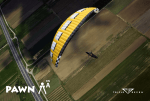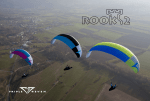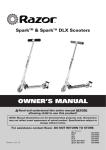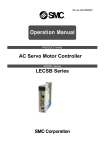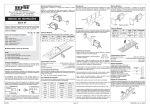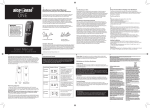Download XC Superstar - Triple Seven Gliders
Transcript
XC Superstar ROOK 777 XC SUPERSTAR USER MANUAL Version 1.6.5, Date: 26.5.2013 Introduction Welcome Welcome to the Triple Seven Team! We are excited that you have chosen to fly the ROOK, as we are confident that this glider will be the next step in your piloting career. We wish you exciting flying adventures! Triple Seven Mission Our company’s goal is to produce high quality products and technologically innovative gliders of all types and classes. We are striving to develop state of the art paragliders, with the optimum compromise between safety and performance, produced in Europe. Your success is our inspiration; our goal is your success. Manual Summary 1.777 XC SUPERSTAR II. Introduction This document contains complete product information and instructions to familiarize you with the main characteristics of your new glider. It contains instructions on how to use and maintain the wing, however, its purpose is not to serve as learning material to pilot this kind of wing. As such, this is not a flying manual. Flying instructions can only be taught by flying schools and specially certified instructors. II.i.Welcome II.ii. Triple Seven Mission III.Manual 4.ROOK It is important that you take time to read this manual carefully before the first flight, as thorough knowledge of your equipment enables you to fly safely and to maximize your full potential. If you borrow or give your glider to another pilot, please pass this manual on with it. 5.1.Elements, components 5.2.Assembly 5.3.Harness 5.4.Accelerator settings 5.5.Brakes’ adjustments 5.6.Weight range 5.7.Wing inflation 5.8.Modifications on the glider 5.9.Preflight safety 6.Flying ROOK If any use of Triple Seven equipment remains unclear after having read this manual, please contact: your local paragliding instructor, your Triple Seven importer or Triple Seven. This product manual is subject to changes without prior notice. Please check www.777gliders.com for the latest information regarding our products. 4.1.Designer’s thoughts 4.2.Who is this glider for? 4.3.Certification 5.Before flight 6.1.First Flight 6.2.Preflight check equipment 3 4 4 4 4 7 8 9 9 10 10 10 11 11 11 12 12 12 12 13 13 13 6.3.Final preflight check 6.4.Inflation, control, take-off 6.5.Line knots or tangles 6.6.Normal flight, best glide 6.7.Minimum sink 6.8.Accelerated flight 6.9.Active flying 6.10. Flying in turbulence 6.11. Fast decent techniques 6.12. Winch launch 6.13. Aerobatics 6.14. Primary controls failure 6.15. Landing 7.Maintenance 14 14 14 15 15 15 15 16 18 19 19 19 19 20 9.1.Technical data 9.2. Materials description 26 26 7.1.General advice 7.2.Packing instructions 7.3.Storage 7.4.Cleaning 7.5.Repair 7.6.Checks and control VIII. Packing ROOK 9.Technical data 20 20 21 21 21 21 22 24 9.3.ROOK risers arrangement 9.4.Line plan ROOK 9.5.Line lengths ROOK L 9.6.Line lengths ROOK M 9.7.Line lengths ROOK S 9.8.Certification specimens X. Safety and responsibility XI.Guarantee XII. Registration information XIII. Get involved XIV. Contact XV.Top 5 XC tips 27 28 29 30 31 34 38 39 40 40 41 43 ROOK rle STE lr ldw BPI »Progressive » handling, offering easy and precise control characteristics »Profile » and trim speed optimized for good climbing »Balanced » wing tension, together with leading and trailing edge reinforcements for greater stability and good gliding performance throughout a wide speed range »Optimized » geometry of the suspension lines and materials for reduced drag and better gliding performance »Good » pitch stability and easy to pilot »Light » weight and easy launch control »A » unique race look »EN-B, » LTF-B certification ROOK is a glider designed by the Valic Brothers, made for local soaring and cross country flying. The glider’s technical design is based on experience and technology of competition wings, with great emphasis on ease of flying and safety. 6 7 Our design goal from the beginning of this project was to make an easy fun flying cross country glider that would satisfy the needs of a broad range of pilots. As always, we were trying to make a better and higher performance glider than available on the market. This glider is no exception, as we took great care of both aspects throughout the whole development process. So while testing and improving the glider for safety and ease of flying, we were always comparing it to other gliders and we must say that we are really happy with the results. Aljaž Valič Who is this glider for? This wing is a high performance EN-B, LTF-B certified glider intended for intermediate to advanced pilots that want safety and high performance in this class. Intermediate pilots may find this glider great for the progression of their piloting XC skills for years, whilst experienced pilots will enjoy the comfort of safety and performance on long cross country flights; even in stronger air. Intermediate Advanced FUN FLY Designer’s thoughts Beginner The pilot of this wing should be comfortable with the basic active flying techniques of controlling a glider in active air, naturally preventing pitch or roll movements. As with any glider, we recommend constantly improving your basic and advanced flying skills. Certification The ROOK has passed the European EN-B certification for all commercially available sizes. The homologation results are enclosed at the end of this manual. 8 9 Before flight Elements, components The ROOK is delivered together with a rucksack, inner bag, compression strap, Triple Seven T-shirt and USB key with this manual. Assembly Before you rush to the first take-off we recommend you take your time to unpack and test your equipment on a training slope. In this way you will have time and will not be distracted or rushed to prepare your equipment, andyou will be able to do your first pre-flight check properly. The place should be flat, free of obstacles, and with light wind. This will enable you to nicely inflate the wing and also familiarize yourself with it while ground handling. Every glider has to be checked by a Triple Seven dealer, however, as a pilot you want to do a proper pre-flight check yourself. Firstly, prepare and spread out the glider like you would normally do. While you are spreading out and walking along the glider, observe the fabric material for any abnormalities. When you are done with the inspection of the canopy, grab the risers and spread the lines, check if the risers and maillons (carabiners) are properly closed. Identify and disentangle the A1, A2, B, C risers and the lines including the brake lines. Connect the risers’ main 10 attachment points correctly to the harness, watch for any twists and make sure that the main carabiners are properly closed. Accelerator settings The ROOK has passed EN-B certification testing using a GH - ABS type harness. This certification allows the ROOK to be flown with most of the harnesses on the market, but keep in mind that the change of a harness greatly influences the feeling of the glider, depending on the effectiveness of the harness weight shift. Check with the harness manufacturer or with your instructor whether your harness is of the proper type. Before attaching the accelerator system to the ROOK risers, check that the speed system inside your harness is correctly routed and that all pulleys are set correctly. Make sure there are no knots or other obstacles that might make the accelerator get stuck during usage. Harness The length of the harness chest strap affects the distance between the main carabiners and the wing’s handling as well as your stability in the harness. Tightening the chest strap increases your stability, but greatly increases the risk of twisting after a collapse. A tight setting also increases the tendency to maintain a deep spiral. As a rule of thumb, a more opened chest strap gives you more feedback from the glider, which is good for your climbing efficiency and increases safety in a flying incident. But we strongly recommend adjusting the length of the harness chest strap according to the lengths used during certification. This setting varies according to the harness size from 42cm to 50cm. Check the settings used during testing under the certification specimen section. We recommend that your first flight with the ROOK is not also with a new harness. Another rule of thumb is if you want to experience the feeling of new equipment, change only one part of equipment at a time. The ROOK speed system increases the speed of the glider by 14km/h with the accelerator at full travel, from trim speed at 38km/h to full speed at 52km/h. The length of the speed bar lines should be adjusted on the ground so that your legs are fully extended at the point of full accelerator travel. While setting the speed line lengths make sure they are long enough, so that the speed system does not accelerate the glider by itself. If in doubt how to properly set the accelerator system, please consult your instructor or Triple Seven dealer. Brakes’ adjustments The length of the brake lines has already been adjusted by the manufacturer and is the same as used during the certification test flights. The length is set and fine-tuned during the development of the glider, therefore generally there should be no need to adjust them. We recommend flying this setting for a while, and you can still change it afterwards if you wish to do so. If you change the length of the brakes, do it in a step by step process of 2 cm at a time. Bear in mind that if you make the brake lines too short, they might be applied unintentionally while the speed system is being used. 11 Weight range Each size of the ROOK is certified for its own weight range. The above mentioned weight includes the weight of the pilot and complete paragliding equipment, together with the glider, harness, all accessories and optional ballast. Every glider changes its characteristics by changing the take-off weight. We recommend that you always fly your glider in the specified weight range. To measure your take-off weight, step on a scale with all your equipment packed in the rucksack. Lower half of the weight range Flying the ROOK, as any other glider, in the lower part of the weight range, causes the agility of the glider to decrease, and when flying through turbulence its tendency for collapses relatively increases as compared to flying it in the upper wing loading range. However, reactions after a collapse are less dynamic and sink rate improves. Therefore, if you mainly fly in weak conditions, you might prefer this weight range. Upper half of the weight range Again, as with any other glider, flying the ROOK in the upper part of the weight range increases the stability and agility of the glider. Consequently, there is a slight increase in the glider’s speed and also gliding performance, especially when flying against the wind. If you normally fly in stronger conditions and you prefer relatively more dynamic flying characteristics, you should set the take-off weight in the higher weight range. Reactions after a collapse may be more dynamic in the upper half of the weight range. 12 Wing inflation Still being on the training slope and having prepared and checked everything, inflate your wing and play with it to get a feel of your new glider while ground handling. By doing this you are making a final check of the canopy and lines, and that everything is in order. You will find that the ROOK inflates very easily and smoothly without excessive energy and with minimum pressure while moving forwards. For inflation and lifting the glider you may use only the A1 risers. Do not pull on the risers just with your hands, instead use your whole harness. Your hands should only accompany the rising movement of the wing. When the wing is above you, apply correct pressure on the brake lines and the glider will stay above you. Modifications on the glider Any modifications of the lines or risers’ speed system cause the loss of the certification, similarly to flying the wing outside the weight range. Preflight safety Before flying the ROOK, you should obtain all practical and theoretical training and the certification for flying this kind of wing. Pilots should be physically and mentally fit, using complete paragliding equipment and flying only in conditions suitable for their level of flying expertise. Flying ROOK First Flight Now that you have already familiarized yourself with your new glider while ground handling on a training slope, you are ready for your first flight. For the first flight it is recommend that you choose a familiar flying area and to fly your new glider in calm conditions. Preflight check equipment Before every flight you need to do a pre-flight check and the inspection of other equipment. Learn to do this, as it takes no extra time. This procedure may vary, depending on the instructor, pilot or equipment settings. Some pilots have their wing always connected to the harness. However you should have a consistent method of checking and preparing your equipment and doing the final pre-flight check. 1. After the arrival on take-off, assess the suitability of flying conditions. 2. While walking around the canopy preparing and spreading out the wing, you should at the same time inspect the canopy. 3. After you check the lines and connect the risers to the harness, grab the lines and slide them through your fingers as you walk towards the canopy. In this way you double check that the lines are not tangled, stuck or damaged. If meanwhile the canopy 13 moves, walk around and correct it again. 4. Inspect the harness, reserve, speed system and all connections. Final preflight check 1. Strap into the harness. The leg straps should be the first to be connected on the take-off and the last ones to be released after the flight. Make sure you are strapped in correctly and wearing a helmet. 2. Check the risers for a twist and that the carabiners are properly closed. Check if the speed system is not affecting your risers – accelerating unintentionally. 3. Check the lines. The A riser lines should be on top, and all lines untangled. Check if none of the lines are lying over or below the canopy. 4. Check the canopy. The glider should be spread out in the shape of an arch and all cells open. 5. Check the wind, take-off and airspace. The wind should be favourable for take-off and the pilot’s level of expertise. Airspace should be cleared, together with the take-off area. Inflation, control, take-off The ROOK has easy take-off behaviour and does not require any additional advice regarding the forward or reverse launch. Try to divide and practice the take-off procedure in three steps. 1. Inflating and raising the glider 2. Controlling the wing and wing check 3. Accelerating and take-off 14 It is always advisable to practice and improve proper launching techniques as this reduces unnecessary additional stress before the take-off. Wind speeds up to 25 to 30km/h are considered strong and extra care is required for the flight. If you are launching in strong winds we recommend the reverse launch technique, with your brakes in the right hands at all times. Launch the glider with a gentle pull and then walk towards it if necessary to reduce the relative wind force. When the glider is above you, gently control the wing and take off. Line knots or tangles If you fail to observe a line knot or you find yourself flying with a knot before being able to prevent the unintentional, uncontrolled take-off, try to stay away from the ground or other pilots by flying away from the mountain, before taking any corrective action on the wing. This means that you weight shift and/or counter brake the opposite side of the wing and control the flying direction with the least amount of force needed for the wing to fly straight away from the mountain. Be careful not to apply too much brake or to fly too slowly to avoid a stall or spin. When you are at a safe distance away from the mountain and you have gained relative height by flying away, you may want to gently and briefly pull the lines that are tangled with the knot. If the knot is on the brake lines you might want to gently and briefly “pump” the appropriate brake line. Please note that by pulling the lines, the knot may get stuck in a worse position and the situation may escalate also to a stall or spin. Therefore, if you estimate that you can control the wing relatively safely and that the knot is not released by gently and briefly pulling the tangled lines, immediately fly to the landing zone and land safely. Normal flight, best glide Without any brakes applied and without using the accelerator, the wing flies at the so called “trim speed“. In calm air this is theoretically the best glide speed. The best speed glide depends on the glider’s polar and air mass, vertical and horizontal speed. We recommend reading more about the theory of the best glide and McCready theory. Minimum sink If you apply brakes on both sides for about 15 to 20cm you will slow the glider to the theoretical minimum sink speed. But we do not recommend using this speed even for thermalling, as you achieve much better climbing and control by letting the glider fly with its “trim speed” and natural energy. With a proper take-off weight you will find that the glider has great climb, reactions and agility. Accelerated flight After you get comfortable flying the ROOK, you can start practicing using the speed system, which will provide better performance while gliding against the wind and through a sinking air mass. The ROOK was designed to be stable through its entire speed range, but this requires the use of active flying techniques. Note that any glider becomes less stable while flying accelerated and that the risk of a collapse is higher in accelerated flight. Additionally, the reaction of the glider to a collapse in accelerated flight is more radical in comparison to the one which occurs at trim speed. We recommend that you avoid accelerated flight near the ground and to be very careful using the accelerator in turbulent conditions. Use a soft speed bar, which enables you to accelerate the glider by using only one leg. To control the direction use weight shift. To control the pitch change the amount of the speed bar. Do not use or pull the brakes while using the speed bar. Use the speed bar progressively when accelerating and instantly release when you feel a slight loss of tension, pressure or even a collapse. If you encounter a collapse while using the accelerator, release the speed bar immediately before taking any other corrective action. Always keep more distance from the ground when using the speed bar. Active flying This is a basic flying technique for any intermediate and advanced pilot. It implies permanent control and the correction of pitch and roll movements together with the prevention of any deflations or collapses. In a nutshell this means flying straight through active or turbulent air, so that the pilot keeps the glider above his or her head at all times, compensating and correcting any unwanted movements of the wing. 15 Few examples: • While entering a strong thermal, the wing will stay a little bit behind relative to the pilot. The pilot should let the brake up allowing the wing to fly faster and to catch up. • If the wing surges in front of the pilot, the pilot should counter brake until the surge is controlled and then release the glider to let it fly normally. • If the pilot feels a loss of tension on the wing or a loss of pressure on the brakes on one side of the wing, he should smoothly apply the brake on the side with loss of pressure and/ or weight shift to the opposite side until the pressure returns. After that, again release the brake and/or weight shift to the neutral position and let the glider fly normally. The key in all cases is to avoid an over-correction and not to maintain any correction longer than necessary. After each action let the glider fly normally again. To re-establish its required flying speed. You can train or get a feeling for most of these movements safely on the ground while ground handling your glider. Good coordination of your movements and coordination with the wing on the ground will enable you a quick progression when actively flying in the air. The next step is to attend SIV courses where you should also get a better understanding of the full brake range and the glider’s speeds. Flying in turbulence Wing deflations can occur in a strong turbulence. The ROOK is designed and tested to recover without pilot’s input in almost all 16 situations by simply releasing the brakes and letting the glider fly. To train and understand all the manoeuvres described, attend SIV courses. that asymmetric collapses are much more radical when flying accelerated. This is due to the difference in weight and the inertia of the canopy and the pilot hanging below. • Cascade of events Many reserve deployments are the result of a cascade of over-corrections by the pilot. Over-corrections are usually not problematic because of the input itself or its intensity; but due to the length of time the pilot continues to over-handle. After every input you have to allow the wing to re-establish its normal flying speed. Note that over-corrections are often worse than no input at all. Symmetric deflations Symmetric or frontal deflations normally reopen immediately by themselves without pilot’s input. The glider will then regain its airspeed accompanied by a small surge forwards. To actively control this event, apply both brakes slightly when the collapse occurs and then instantly release the brakes to let the glider fly. Be prepared to compensate for the glider’s slight surge forward while returning to normal flying. Negative spin In normal flight you are far from negative spin. But, certain circumstances may lead to it. Should this occur, just release the brake lines progressively and let the wing regain its flying speed. Be prepared for the glider to surge forward, compensating the surge with brake input if necessary. Asymmetric deflations Strong turbulence may cause the wing to collapse asymmetrically. Before this occurs the brake lines and the feeling of the harness will transmit a loss of pressure to the pilot. This feedback is used in active piloting to prevent a collapse. If the collapse does occur, the ROOK will easily re-inflate without the pilot’s reaction, but the wing will turn towards the collapsed side. Wing tangle, cravat A cravat is very unlikely to happen with the ROOK, but it may occur after a severe deflation or in a cascading situation, when the wing tip gets caught in the glider’s lines. A pilot should be familiar with the procedure of handling this situation with any glider. Familiarize yourself with the stabilizer’s main line (“stabilo” line) already on the ground. If a cravat occurs, the first thing to do is to try to keep the glider flying on a straight course. Do this by weight shifting and counter braking the untangled side. After that, grab the stabilizer’s main line on the tangled side and pull it down until it becomes tight again. At this point the cravat normally releases itself. To prevent this from happening turn and actively recover the asymmetric collapse by weight shifting and applying appropriate brake input on the side that is still flying. Be careful not to overbrake your wing’s flying side. This is enough to maintain your course and give the glider enough time to recover the collapsed side by itself. To actively reopen the collapsed side after course stabilization, pull the brake line on the collapsed side firmly and release it. You can do this several times with a smooth pumping motion. After the recovery, release the brake lines for your glider to regain its trim speed. You must be aware of the fact Possible solutions of the cravat situations (consult your SIV instructor): • Pulling the wing tip “stabilo” line • Using a full stall, but it is essential to be very familiar with this manoeuvre. You also want to have a lot of relative height. If you are in a situation where you have a cravat and you are low in rotation or even with twisted risers, then the only solution is the reserve parachute. Full stall A full stall does not occur unintentionally on its own – it happens if you pull both brakes for 100% and hold them. The wing then performs a so called full stall. Releasing the brakes improperly may lead to massive surge of the glider with danger of falling into the canopy. This is a complex manoeuvre and as such outside the scope of this manual. You should practice and learn this manoeuvre only on a SIV course under professional supervision. Deep stall Generally when in deep stall, the wing has no forward motion and at the same time high sink speed. When in deep stall the wing is almost fully inflated. With the ROOK it is very unlikely to get into this situation unintentionally. This could possibly happen if you are flying at a very low speed in turbulent conditions. Also the porosity of the material and line stretch on a very old glider can increase the possibility of the deep stall tendency. If you trained this manoeuvre on a SIV course you would realize that it is very hard to keep the ROOK in deep stall. If you apply the brakes a little bit too much you enter the full stall. If you release the brakes 17 just a little bit too much the wing returns to normal flight. If you want to practice the deep stall on SIV courses, you need to master the full stall first. Fast decent techniques Fast descent techniques should be well familiar to any pilot as they are important resources to be used in certain situations. These manoeuvres should be learned at your flying school as a part of paragliding pilot training. Nevertheless, we recommend practicing these manoeuvres on SIV courses under professional supervision. Big ears This is a safe method to moderately loose altitude while still maintaining forward speed. To do big ears, release any brake line loops around your wrist, set your leg on the speed bar, but do not push it. Now pull the outer A lines (the A2 risers in the drawing) on both sides. As long as you keep the A2 risers pulled, the wing tips stay folded and the sink speed increases. To regain normal flight, release the A2 risers, and if necessary apply the brakes with short impulse movements. Release big ears at least 100 meters above the ground. While using big ears, the wing speed decreases, which is why we also recommend using the accelerator half way in combination with big ears to maintain enough horizontal speed and to also additionally increase vertical speed. Be careful not to pull the brakes while making the ears! Steering is done by weight shift only. Always do the big ears first and then accelerate; not the other way around as you will risk getting a frontal collapse. B line stall While in the B-stall the glider has no horizontal speed and the 18 sink rate increases to about -8m/s. To enter the B-stall reach for the B risers just below the maillons and pull both B line risers symmetrically for about 20 cm. To exit the manoeuvre, simultaneously release both risers quickly. On exit the ROOK gently dives without deep stall tendencies. Spiral dive The spiral dive is the most demanding of all three manoeuvres (Big ears, B-stall, Spiral) and should only be trained gradually and always at high altitude. The spiral dive should be practiced and learned on a SIV course under professional supervision. To enter the spiral, weight shift to the desired side and gradually apply the brake on the same side. Then let the wing accelerate for two turns and you will enter the spiral dive. While in the spiral, you can control your descent rate and bank angle by applying more or less inner brake. Depending on how steep the spiral is you may need to use also outer brake. To exit the spiral dive we recommend that the pilot is in the neutral weight shift position. If you release the inner brake, the wing exits the spiral dive by itself. The ROOK has no tendency of a stable spiral but you should be aware of the procedure for exiting a stable spiral. To exit a stable spiral dive, weight shift to the opposite side of the turn and apply the outer brake until feeling the deceleration of the wing rotation. Then release the outer brake and let the glider decelerate for the next couple of turns. To avoid a big pendulum movement after exiting the spiral, apply a short brake input on the inner side before the glider exits the spiral. Warnings (Spiral dive): • There is a possibility of losing consciousness while in the spiral dive. Never make a spiral with more than 16-18m/s sinking speed. • In fast spirals it may be necessary to apply the outer brake to begin exiting the spiral dive. • If practicing the spiral dive low, a pilot may not have enough altitude or time to safely exit this manoeuvre. Winch launch The ROOK is easy to launch using a winch and has no special characteristics considering this kind of launching. To practice this launching technique special training is needed and you have to be aware of the procedures and dangers, which are specific for winching. We do not recommend using any special towing device which accelerates the glider during the winch launch. Aerobatics The ROOK was not designed for aerobatics, therefore, these may not be performed on this glider. In addition to this, any extreme manoeuvres place unnecessary stress on the glider and shorten its lifespan. risers to control and steer the wing. Be careful not to over-handle the glider by using the C riser technique when steering. By pulling the C risers too strong you can cause a stall or a negative spin. Land your glider at trim speed without using the C risers, to avoid over-handling the glider low above ground. We recommend using weight shift. Landing Similarly to the take-off, the ROOK’s landing characteristics are easy. In turbulent conditions it is advisable to apply about 15% of the brakes, to increase stability and the feeling of the glider. Before landing, adopt the standing position as this is the most effective and the safest way to compensate the touch down with your legs. Again we recommend training the landing manoeuvre, as it might be useful to be able to land in small places, especially in an unknown cross country terrain. Learn to evaluate the wind direction by observing the signs on the ground and also your drift while making turns. This proves to be useful for cross country, when landing outside of your usual landing field. Another advice we suggest taking into account in stronger winds is to go higher for the landing fields and thus assuring you reach them. Likewise, always look for possible alternatives downwind. Primary controls failure If for any reason you cannot use the brake lines, you have to pilot the wing to the landing place by using weight shift. Weight shift should be enough to safely land the glider. You can also use the C 19 Maintenance General advice Careful maintenance of your glider and the following simple guidelines will ensure a much longer airworthiness and performance of your wing: • Pack your glider after you land and do not unnecessarily expose it to UV radiation by leaving it on the landing site unpacked. The sun UV radiation degrades the cloth and lines material. • Fold your glider like recommended under the section of packing instructions. • If the glider is damp or wet when you pack it, partially unfold it at home to allow it to dry. Do not dry it in direct sunlight. • Avoid exposing the glider to violent shocks, such as the leading edge hitting the ground. • Avoid dragging the glider on the ground or through rocky terrain as you might damage the lines or canopy. • Avoid stepping on the lines or canopy, especially when they are lying on a hard surface. • Avoid exposing the glider to salt water, as it damages the lines and the canopy material (wash with fresh water). • Avoid bending your lines, especially in a small radius. • Avoid opening your glider in strong winds without first untangling the lines. • In general, avoid exposing your glider to very hot or humid environments, UV radiation or chemicals. 20 Packing instructions It is important to correctly pack your glider as this prolongs its lifespan. We recommend that you fold the glider like a harmonica, neatly aligning the profiles with the leading edge reinforcements side by side. The wing should then be folded in three parts or two folds. The wing should be packed as loosely as possible. While packing be careful not to trap any grasshoppers inside your canopy as they will tear the canopy cloth. This technique will make your glider last longer and ensure its best performance. Storage Correctly packed, store your glider in a dry place at room temperature. The glider should not be stored damp, wet, sandy, salty or with objects inside the cells of the glider. Keep your equipment away from any chemicals. Cleaning If necessary always clean your glider with fresh water and a cloth only, without using any cleaning chemicals. This includes also the lines and canopy. More importantly, always remove any stones or sand from the canopy as they will gradually damage the material and reduce the glider’s lifespan. Repair Checks and control To ensure the wing’s airworthiness the ROOK has to be periodically serviced and checked to guarantee that the glider continues to fulfil the EN certification results and to extend your glider’s lifespan. We recommend a line check and trim inspection every 100 hours or 12 months depending what happens first. After that, the glider needs to be fully checked after 150 hours or 24 months of usage, whichever comes earlier. This inspection includes checking the suspension lines, line geometry, riser geometry and the permeability of the canopy material. A certified inspector can then define the check interval depending on the glider’s condition. Please note that the condition of the glider can vary considerably depending on the type of usage and environment. Salty coastal air or dunes will considerably affect your wing’s material. For more information please visit our website. To repair small damages (less than 5cm) on the canopy cloth, you can use the rip stop tape. Greater damages, including stitches and lines must be repaired by a specialized repair shop. Damaged lines should be replaced by a Triple Seven dealer. When replacing a line it should always be compared with the counterpart for adjusting the appropriate length. After the line was repaired, the wing should be inflated before flying, to ensure that everything was done correctly. Major repairs, such as replacing panels, should only be carried out by a Triple Seven distributor or Triple Seven. If you are unsure about the damage or in any doubt please contact Triple Seven. 21 Packing ROOK 3. Fold leading edge back toward trailing edge and align the cels 1. Fold the glider like harmonica 4. Fold the glider in three parts 2. Align the cells 5. Finished Check the video: http://777gliders.com/content/packing-rook 22 23 Technical data 4. 3. 1. 2. 3. 4. 5. 6. Suspension lines Risers Main lines Middle cascades Upper cascades Brake lines 6. 5. 5. 1. 2. 3. 4. 5. 6. Canopy Bottom surface Top surface Leading edge Trailing edge Intake cell openings 2. 4. 1. 1. 3. 2. 24 6. 25 Technical data SIZE CELLS FLAT PROJECTED ROOT CHORD RISERS ROOK S ROOK S NUMBER AREA SPAN ASPECT RATIO AREA SPAN ASPECT RATIO Materials description m2 m m2 m ROOK S 53 24.5 11.6 5.447 20.7 9.2 4.095 2.642 ROOK M 53 26.5 12.0 5.447 22.4 9.5 4.095 2.748 ROOK L 53 28.5 12.5 5.447 24.1 9.9 4.095 2.849 LENGTHS (mm) LENGTHS (mm) A 560 400 B C 560 560 STANDARD 450 560 ACCELERATED S-Distance between pulleys: 160 ROOK M ROOK M LENGTHS (mm) LENGTHS (mm) 580 400 580 580 STANDARD 465 580 ACCELERATED M-Distance between pulleys: 180 ROOK L ROOK L LENGTHS (mm) LENGTHS (mm) 600 400 600 600 STANDARD 480 600 ACCELERATED L-Distance between pulleys: 200 SIZE TRIMS IN FLIGHT WEIGHT MINIMUM MAXIMUM GLIDER WEIGHT CERTIFICATION 26 kg kg kg EN ROOK S NO ROOK M ROOK L NO NO 70 85 4.8 B 80 105 5.5 B 100 120 6.0 B CANOPY FABRIC CODE Upper surface NCV 9092-E85A, NCV 9017-E77A Bottom surface NCV 9017-E68A Profiles NCV 9017 - E29A Diagonals NCV 9017 - E29A Loops COUSIN 608 10mm Reinforcement loops NCV F06391 - E45A Internal construction D-Ribs, NCV 9017 - E29A H-Straps, Mini ribs Thread Serafil 40/2000, 60/2000 SUSPENSION LINES FABRIC CODE Upper cascades Edelrid A-7000-120-000 Upper cascades Edelrid A-7000-080-000 Upper cascades Edelrid A-7000-065-000 Middle cascades Edelrid A-7000-065-000 Main Main Brake lines Brake lines Main brake Thread RISERS Material Material Color indicator Thread Brake Swivel Maillons Pulleys ROOK risers arrangement 5. 11. 1. 2. 10. 3. 4. 9. Edelrid A-7000-200-000 Edelrid A-7000-160-00 Cousin 12110/0.6 - Dyneema Cousin 12250/0.9 - Dyneema Cousin Red 260 / 2.1mm Dyneema Serafil Amann 60/0415 FABRIC CODE Webbing Cousin 3455-12mm, Güth & Wolf 70 404/12,5mm Dyneema Cousin 3455-12mm Kevlar Omnitech 200/200PU Serafil Amann 20/4000, 20/1078 Fob ningbo - china 6mm Rapid Peguet MRNI03.0 4x Harken 467 16mm ball bearing pulley 12. 1. A1 riser 2. A2 riser, (Ears) 3. B riser, (B-Stall) 4. C riser 5. Maillons 6. Main attachment point 7. Speed bar attachment point 8. Speed bar pulleys (200mm) 9. Brake handle 10. Brake line pulley 11. Main brake line 12. Clip for brake handle 13. ROOK has no trimmers or any other adjustable or removable device 8. 7. 6. 27 Line plan ROOK Line lengths ROOK L Triple Seven ROOK L Lines Length (mm) First gallery Lines A mm Lines B mm Lines C mm Lines D mm BR lines mm a1 1921 b1 1765 c1 508 d1 652 br1 1643 a2 1881 b2 1732 c2 521 d2 655 br2 1253 a3 1792 b3 1634 c3 471 d3 606 br3 1033 d4 649 a4 1773 b4 1632 c4 537 a5 2188 b5 2143 c5 2066 1303 1220 a6 2051 b6 2022 c6 1929 br6 1321 a7 2066 b7 2024 c7 1908 br7 720 c8 981 br8 662 br9 637 br10 633 br11 585 br12 531 a8 1130 b8 1081 a9 894 b9 890 Second gallery Lines A Main Lines Lines A 28 br4 br5 mm mm Lines B Lines B mm mm Lines C mm 1c1 1014 Lines D mm BR lines mm 1br1 1350 1c2 985 1br2 879 1c3 944 1br3 1661 1c4 869 1br4 1612 1br5 1653 BR lines mm Lines C mm Lines D mm Stabilo Lines STB mm 1a1 4885 1b1 4945 2c1 5301 2br1 1823 stab2 496 1a2 4961 1b2 5036 2c2 5382 2br2 1402 stab1 568 1a3 4521 1b3 4486 2c3 4653 3br1 1570 stab. main 4638 br main 1815 cut, 1607 mark 29 Line lengths ROOK M Line lengths ROOK S Triple Seven ROOK M Lines Length (mm) Triple Seven ROOK S Lines Length (mm) First gallery Lines A mm Lines B mm Lines C mm Lines D mm BR lines mm a1 1852 b1 1702 c1 490 d1 626 br1 1584 First gallery Lines A mm Lines B mm Lines C mm Lines D mm BR lines mm a1 1778 b1 1634 c1 470 d1 601 br1 1521 a2 1814 b2 1670 c2 502 d2 632 br2 1208 a2 1741 b2 1603 c2 482 d2 607 br2 1160 a3 1726 b3 1576 c3 454 d3 584 br3 996 a3 1657 b3 1513 c3 436 d3 561 br3 956 d4 626 d4 601 a4 1710 b4 1574 c4 518 a5 2110 b5 2066 c5 1992 br4 1256 a4 1642 b4 1511 c4 497 br5 1176 a5 2026 b5 1983 c5 1912 br4 1206 br5 1129 a6 1978 b6 1950 c6 1860 br6 1274 a6 1899 b6 1872 c6 1786 br6 1223 a7 1998 b7 1968 c7 1840 br7 694 a7 1912 b7 1874 c7 1766 br7 666 c8 946 br8 638 a8 1046 b8 1000 c8 908 br8 612 br9 614 a9 828 b9 824 br9 589 br10 610 br10 586 br11 564 br11 541 br12 512 br12 492 a8 1098 b8 1042 a9 862 b9 858 Second gallery Lines A Main Lines Lines A mm mm Lines B Lines B mm mm Second gallery Lines C mm BR lines mm Lines C mm BR lines mm 1c1 978 1br1 1302 1c1 939 1br1 1250 1c2 950 1br2 848 1c2 912 1br2 814 Lines D mm Lines A mm Lines B mm Lines D mm 1c3 910 1br3 1602 1c3 874 1br3 1538 1c4 838 1br4 1554 1c4 804 1br4 1492 1br5 1594 1br5 1530 BR lines mm BR lines mm Lines C mm Lines D mm Stabilo Lines STB mm Main Lines Lines A mm Lines B mm Lines C mm Lines D mm Stabilo Lines STB mm 1a1 4710 1b1 4768 2c1 5112 2br1 1758 stab2 478 1a1 4522 1b1 4577 2c1 4914 2br1 1688 stab2 459 1a2 4784 1b2 4856 2c2 5194 2br2 1352 stab1 548 1a2 4593 1b2 4662 2c2 4969 2br2 1298 stab1 526 1a3 4359 1b3 4326 2c3 4487 3br1 1514 stab. main 4472 1a3 4185 1b3 4145 2c3 4288 3br1 1453 stab. main 4299 br main 1750 cut, 1550 mark br main 1728 cut, 1536 mark 30 31 32 33 Certification specimens Dive forward angle on exit / Change of course Dive forward 0° to 30° / Keeping course Cascade occursN Flight test report: EN AD oA 11. Exiting deep stall (parachutal stall) A Deep stall achieved YesA ive forward 0° to 30° / Entering a turn of less than 90° A 16. Trim speed spin tendency No A 17. Low speed spin tendency YesA pontaneous in less than 3 s AS pontaneous in less than 3 s A Dive forward angle on exitD ive forward 0° to 30° AD ive forward 0° to 30° A AC hanging course less than 45° A Changing course less than 45° Cascade occursN oA No A 12. High angle of attack recoveryA Manufacturer 777 jadralna padala d.o.o. Certification number PG_0547.2012 RecoveryS pontaneous in less than 3 s Address Ulica Ane Ziherlove 10 1000 Ljubljana Slovenia Date of flight test 28. 02. 2012 Cascade occursN oA RepresentativeA Glider model liaz Valic Class: B Berruex Gilles Harness Sup' Air - Altiplume M 777 jadralna padala d.o.o. Rook M 105 1. Inflation/Take-offA Rising behaviour Smooth, easy and constant rising AS Special take off technique requiredN 2. Landing oA mooth, easy and constant rising No A oA No A A Trim speed more than 30 km/h YesA YesA Speed range using the controls larger than 10 km/h YesA YesA Configuration during flight tests Minimum speed Less than 25 km/h 4. Control movement A Paraglider Symmetric control pressure / travel Maximum weight in flight (kg) 105 Range of speed system (cm) 20 Minimum weight in flight (kg) 80 Speed range using brakes (km/h) 14 Glider's weight (kg) 4.8 Range of trimmers (cm) 0 Number of risers 3 Total speed range with accessories (km/h) 28 Harness used for testing (max weight) not available0 Symmetric control pressure / travel Increasing / greater than 60 cm Symmetric control pressure / travel not available0 5. Pitch stability exiting accelerated flight A not available0 A Reducing A Tendency to return to straight flightS 8 9 10 11 12 13 14 15 16 17 18 19 20 21 22 23 24 A A A A A A A A B B A A B B A A A A A B A A A 0 Increasing / greater than 65 cm AD ive forward less than 30° AR pontaneous exitA educing A Re-inflation behaviour Spontaneous re-inflation AS Total change of course Less than 360° A B Sink rate after two turns 12 m/s to 14 m/sA 10. Symmetric front collapse B Entry Rocking back less than 45° AR ocking back less than 45° pontaneous in 3 s to 5 s BS pontaneous in less than 3 sA RecoveryS Dive forward angle on exit / Change of course Dive forward 0° to 30° / Keeping course RecoveryS Less than 90° / Dive or roll angle 0° to 15° pontaneous re-inflation Less than 360° AD oA Rocking back less than 45° AR pontaneous in 3 s to 5 s BS ocking back less than 45° A Dive forward angle on exitD ive forward 0° to 30° Cascade occursN oA Entry procedureD edicated controls AS tandard technique A table flight AS table flight A RecoveryS pontaneous in 3 s to 5 s BS pontaneous in less than 3 sA Dive forward angle on exitD ive forward 0° to 30° AD ive forward 0° to 30° A A A A A Entry procedureD edicated controls AS tandard technique A Behaviour during big earsS table flight AS table flight A RecoveryS pontaneous in 3 s to 5 s AS pontaneous in less than 3 sA Dive forward angle on exitD ive forward 0° to 30° AD ive forward 0° to 30° A AS table flight A Tendency to return to straight flight Spontaneous exitA B Turn angle to recover normal flight Less than 720°, spontaneous recovery A Sink rate when evaluating spiral stability [m/s]1 Total change of course Less than 360° A pontaneous re-inflation Less than 360° A Stable flight Spontaneous exitA A 61 Less than 720°, spontaneous recovery 23. Alternative means of directional controlA Collapse on the opposite side occursN oA No A 180° turn achievable in 20 sY oA No A Stall or spin occursN Cascade occursN oA No A 24. Any other flight procedure and/or configuration described in the user's manual 0 Less than 90° / Dive or roll angle 15° to 45° A Procedure works as described not available0 not available0 Procedure suitable for novice pilots not available0 not available0 A Cascade occurs not available0 not available0 Less than 360° A 25. Comments of test pilot No A Comments oA Twist occursN oA No A Cascade occursN oA No A 90° to 180° / Dive or roll angle 15° to 45° B A 8 Twist occursN pontaneous re-inflation A A 90° to 180° / Dive or roll angle 15° to 45° AS ive forward 30° to 60° NoA 20. Big earsB 22. Behaviour exiting a steep spiralA Spontaneous re-inflation AD Behaviour during big earsS A Re-inflation behaviour Spontaneous in less than 3 sA A No A A pontaneous in less than 3 sA oA Less than 360° A A RecoveryS Cascade occursN A ive forward 0° to 30° / Entering a turn of less than 90° A emains stable with straight span Behaviour immediately after releasing the accelerator while maintaining big ears AS No hanging course less than 45° AR A Spontaneous re-inflation A AC Remains stable with straight span A Less than 90° / Dive or roll angle 15° to 45° More than 14 m/sB Changing course less than 45° No B A Behaviour before release No 90° to 180° / Dive or roll angle 15° to 45° tops spinning in less than 90° NoA Change of course before release oA Change of course until re-inflation / Maximum dive forward or roll angle AS oA oA Re-inflation behaviour A Stops spinning in less than 90° Cascade occursN Collapse on the opposite side occursN Change of course until re-inflation / Maximum dive forward or roll angle With accelerator Entry ost lines tight Spin rotation angle after release A oA Less than 45° NoA 19. B-line stallA Twist occursN A Spontaneous exitA 9. Behaviour in a steeply banked turn Cascade occursN es oA AY es A NoA With 75% collapse and accelerator Change of course until re-inflation / Maximum dive forward or roll angle 90° to 180° / Dive or roll angle 15° to 45° B Re-inflation behaviour Spontaneous re-inflation AS Total change of course Less than 360° A pontaneous re-inflation A Less than 360° A Collapse on the opposite side occursN oA No A Twist occursN oA No A oA No A Cascade occursN 15. Directional control with a maintained asymmetric collapse A Able to keep course YesA 180° turn away from the collapsed side possible in 10 sY Amount of control range between turn and stall or spin es More than 50 % of the symmetric control travel YesA AY AM es ore than 50 % of the symmetric control travel A A pontaneous in less than 3 sA Flight test report: PG_0547.2012 / page 1 of 3 34 Less than 90° / Dive or roll angle 15° to 45° A A o collapse B NoA oA 18. Recovery from a developed spinA 21. Big ears in accelerated flight Change of course until re-inflation / Maximum dive forward or roll angle No 8. Stability in gentle spirals 7 B oA Oscillations 6 14. Asymmetric collapse ive forward 30° to 60° With 50% collapse and accelerator not available0 A 7. Roll stability and damping 5 AM Collapse on the opposite side occursN Warning! Before use refer to user's manual 4 Most lines tight A Person or company having presented the glider for testing: Aliaz Valic 3 Line tension A Access 2 A No Collapse occursN 1 AN Less than 45° ive forward less than 30° Sup' Air 46 AN No oA Harness model 49 No collapse Rocking back Collapse occursN Harness brand every 12 months or every 100 flying hours AD Cascade occurs (other than collapses) Dive forward angle on exitD 6. Pitch stability operating controls during accelerated flight Inspections (whichever happens first) ive forward 0° to 30° Collapse Total change of course ABS Distance between risers (cm) A Max. weight in flight greater than 100 kg Harness type Harness to risers distance (cm) Less than 25 km/h Max. weight in flight 80 kg to 100 kg 22.4 Projected area (m2) A Max. weight in flight up to 80 kg Accessories A With 75% collapse 3. Speed in straight flight Serial number: A A Special landing technique requiredN No A With 50% collapse Sup' Air - Access Total weight in flight (kg) 80 PG_0547.2012 09. 03. 2012 Date of issue (DMY): Model: Villeneuve lassificationB Test pilot Thurnheer Claude In accordance with EN standards 926-2:2005 & 926-1:2006: Manufacturer: Place of test o pontaneous in less than 3 s B Dive forward angle on exitD Rook MC Trimmern 13. Recovery from a developed full stall AS oA A Spin occursN RecoveryS Change of course A Spin occursN Flight test report: PG_0547.2012 / page 2 of 3 Flight test report: PG_0547.2012 / page 3 of 3 35 36 37 Safety and responsibility Paragliding is a dangerous and high risk activity, where safety depends on the person practicing it. By purchasing this equipment you are responsible to be a certified paragliding pilot, and you accept all risks involved in paragliding activities, including serious injury and death. Improper use or misuse of paragliding equipment considerably increases these risks. Guarantee Triple Seven WARRANTY: All Triple Seven products are fully warranted for 24 months, against material defects that are not the result of normal wear or accidental damage. The designer, manufacturer, distributor, wholesaler and retailer cannot and will not guarantee your safety when using this equipment or accept responsibility for any damage, injury or death as a result of the use of this equipment. This equipment should only be used by qualified and competent pilots or by pilots under supervision of qualified paragliding instructors. You must not use this equipment if you are not trained. You alone as a qualified and competent pilot must take full responsibility to ensure that you understand the correct and safe use and maintenance of this paragliding equipment and to use it only for the purpose that it was designed for and to practice all proper safety procedures before and during its use. 38 39 Registration information To fully use all Triple Seven maintenance and warranty services you need to register your glider on our website. Wanting to provide good product support, we invite you to do so, even if you bought your glider second-hand. Triple Seven Warranty & Product registration: http://www.777gliders.com/tripleseven/support Get involved As a new Triple Seven pilot we invite you to contact us in case of any technical or practical issues regarding equipment or techniques. We also invite you to send us your flying photos, videos or even postcards. We would like to hear from you and your exciting adventures with your new ROOK! Finally, join our Facebook community and share the passion. Have fun! 40 Contact Triple Seven Gliders Company: 777 jadralna padala d.o.o. Address: Ulica Ane Ziherlove 10 Postal Code / City: 1000 Ljubljana Country: Slovenia Tel.: +386 40 777 313 Email: [email protected] Online resources For complete help, the latest news, product information and support go to: Official website: www.777gliders.com Facebook: www.facebook.com/TripleSevenParagliders Newsletter register: www.777gliders.com/newsletter/subscriptions Ask questions, make suggestions General questions: [email protected] 41 Top 5 XC tips 1. Master your equipment and techniques. Climbing is the most important! Practice it, especially in weak conditions and don’t be afraid to bomb out. Attend safety and XC courses and learn to fly your glider safely along its full speed range. 2. When circling in a weak thermal, cruise and explore it for better lift. When you hit strong cores, tighten up! 3. Know the theory and try it out! Imagine thermals and when you find them, look down and think... Where is it coming from? What was the trigger? Look around, Look around, Look around! Use every sign of luck and don’t hesitate to take it. 4. Plan your XC at home and let your imagination free. In this way, you will have a mission on the takeoff and you will not be taken by surprise at cloud base, not knowing what to do next. 5. Fly together with friends and have fun! Share exciting experiences, ask questions and don’t forget the first rule of aviation - always have an alternative option or plan B. “Primoz Susa” 42
























